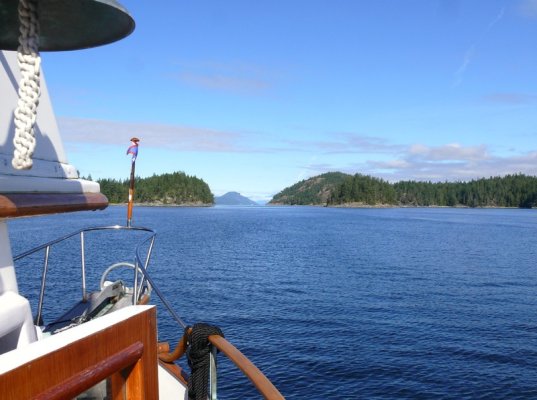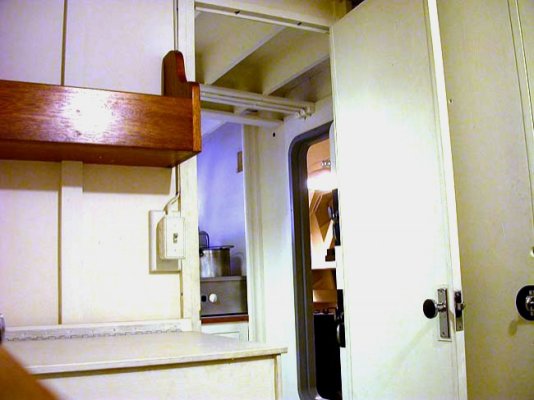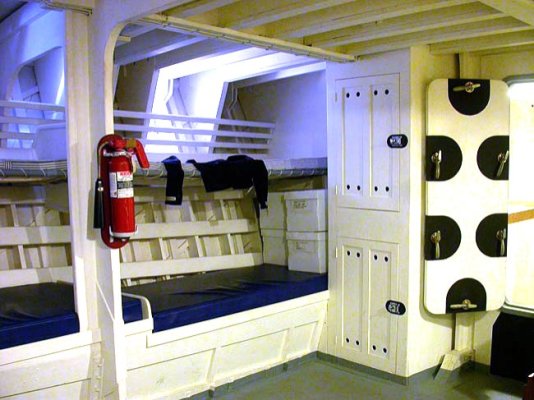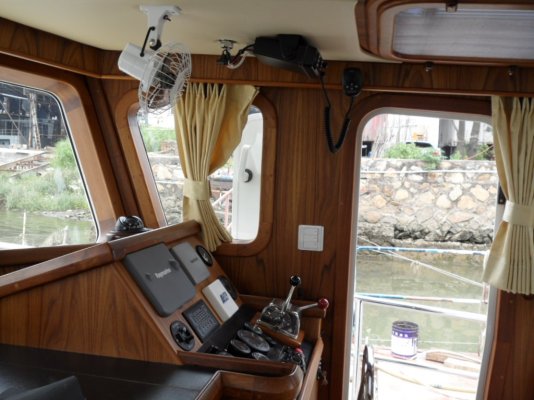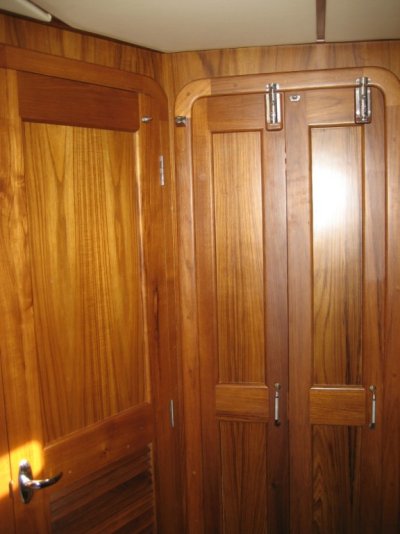You are using an out of date browser. It may not display this or other websites correctly.
You should upgrade or use an alternative browser.
You should upgrade or use an alternative browser.
Boat doors
- Thread starter Forkliftt
- Start date
The friendliest place on the web for anyone who enjoys boating.
If you have answers, please help by responding to the unanswered posts.
If you have answers, please help by responding to the unanswered posts.
I would imagine they do that because the boat flexes and if it were square they would most likely get into a bind. If you have some pictures that would be great, I am beginning to get into the design of my interior and it would be nice to see what other folks have to get some ideas. Thanks Paul
Forkliftt
Guru
- Joined
- Oct 6, 2007
- Messages
- 2,450
- Location
- USA
- Vessel Name
- KnotDoneYet
- Vessel Make
- 1983 42' Present Sundeck
Hey Paul. I suspect that too, funny thing is our entry door has hard corners. I'm at the boat with only an iPhone and have never figured out how to post pics using it on the Forum.
*Ours aren't.* Every GB I've been on including ours and the one we chartered has "normal" interior and exterior doors with sharp, square corners and edges.Forkliftt wrote:
Why are most interior boat doors round on the top? An inquiring Admiral wants to know. They look great for sure- but is there a reason other than looks??
-- Edited by Marin on Sunday 13th of November 2011 12:42:41 PM
Attachments
I suspect your second example is just for style. True watertight doors have rounded tops and bottoms and are set a few inches to a couple of feet off the floor. I assume this is because a rounded shape will hold pressure more reliably than a square-cornered shape. Remember the deHaviiland Comet, the first jet airliner? After they entered service several of them "exploded" at altitude. The cause was eventually found to be in the window design, which featured square or nearly square corners. The flexing of the fuselage due to the pressurizatin and depressurization of the cabin caused fatigue cracks to develop in the skin at the corners of some windows until the structure suddenly let go entirely under pressure and the plane disintegrated. The solution was to ovalize the window openings, which is why they are that way in today's planes.
Plus I would imagine it is easier to get a good watertight seal around a door with rounded corners or ends instead of having a sharp angle in the door seals at every corner.
None of this is necessary in a recreational cruiser, at least not a coastal one, but the oval design has become part of the nautical "look," hence the door in your second photo. If the curved top actually offered any real benefit, the door to the left of it would have this too. So it's just style.
I don't think the "flexing boat, sticking door" theory holds any water.* We've never had that problem on our boat. Here are two shots from my collection of PT photos that were taken on board the only totally restored and original Elco 80' PT boat in existance, a boat I've spent a fair amount of time on.* These were wood boats that were designed to travel at speeds up to 45 mph in the open ocean. Plenty of vibration and flexing I would say.* Where they needed a watertight door there was a rounded watertight door.* Where they needed a door but not a watertight one, the door was sharp-edged and square cornered.
First shot shows the watertight door into the crew head and shower area in the forepeak.* Second shot is a connecting door in the officer's quarters on the port side of the boat amidships.* The watertight door into the officer's area is visible in the bulkhead on the other side of the connecting door.
-- Edited by Marin on Sunday 13th of November 2011 02:20:02 PM
Plus I would imagine it is easier to get a good watertight seal around a door with rounded corners or ends instead of having a sharp angle in the door seals at every corner.
None of this is necessary in a recreational cruiser, at least not a coastal one, but the oval design has become part of the nautical "look," hence the door in your second photo. If the curved top actually offered any real benefit, the door to the left of it would have this too. So it's just style.
I don't think the "flexing boat, sticking door" theory holds any water.* We've never had that problem on our boat. Here are two shots from my collection of PT photos that were taken on board the only totally restored and original Elco 80' PT boat in existance, a boat I've spent a fair amount of time on.* These were wood boats that were designed to travel at speeds up to 45 mph in the open ocean. Plenty of vibration and flexing I would say.* Where they needed a watertight door there was a rounded watertight door.* Where they needed a door but not a watertight one, the door was sharp-edged and square cornered.
First shot shows the watertight door into the crew head and shower area in the forepeak.* Second shot is a connecting door in the officer's quarters on the port side of the boat amidships.* The watertight door into the officer's area is visible in the bulkhead on the other side of the connecting door.
-- Edited by Marin on Sunday 13th of November 2011 02:20:02 PM
Attachments
Codger2
Guru
- Joined
- Oct 11, 2007
- Messages
- 6,691
- Location
- US
- Vessel Name
- Circuit Breaker
- Vessel Make
- 2021..22' Duffy Cuddy cabin
*Marin wrote:
*I assume this is because a rounded shape will hold pressure more reliably than a square-cornered shape.
This is true in a lot of design criteria. Molded plastic parts, fiberglass molds, etc. The molecules align themselves in a straightline pattern at any sharp corner whereas with a rounded (radius) corner the molecules assume an irregular path. (Less chance for stress cracking.) That's why you "stop drill" a hole at each end of a crack to stop it from spreading.
None of this is necessary in a recreational cruiser, at least not a coastal one, but the oval design has become part of the nautical "look," hence the door in your second photo.
A friend of mine who is a NA says that the arched doors on the interiors of yachts "actually do" have a benefit, though its a generally unperceived one. When people approach an arched doorway, they automatically center themselves in the middle of the doorway although they are not aware of doing so. Whether this is correct or arched doors are done for design effect is debatable. He says that along with spreading the loads (stress) evenly in the passageways of ships, (think war ships) and hatch sealing capabilities, aligning yourself up for going through the hatch (which is done subconsciously) is the main focus of the design .
*SeaHorse II wrote:....aligning yourself up for going through the hatch (which is done subconsciously) is the main focus of the design .
*Don't know I agree with this bit.* Notice the watertight door shape in my PT photos.* They are not oval, but simply have well rounded corners.* Most of the upper and lower frames are straight.
Also, it's been my observation from going through watertight doors on this particular PT as well as for work on submarines, the assault carrier USS Peleliu, and the fleet carrier USS Constellation that the watertight doors are not much wider than a person anyway.* So simply going through the door centers you up in it automatically
Forkliftt
Guru
- Joined
- Oct 6, 2007
- Messages
- 2,450
- Location
- USA
- Vessel Name
- KnotDoneYet
- Vessel Make
- 1983 42' Present Sundeck
*SeaHorse II wrote:
Marin wrote:
*I assume this is because a rounded shape will hold pressure more reliably than a square-cornered shape.
This is true in a lot of design criteria. Molded plastic parts, fiberglass molds, etc. The molecules align themselves in a straightline pattern at any sharp corner whereas with a rounded (radius) corner the molecules assume an irregular path. (Less chance for stress cracking.) That's why you "stop drill" a hole at each end of a crack to stop it from spreading.
None of this is necessary in a recreational cruiser, at least not a coastal one, but the oval design has become part of the nautical "look," hence the door in your second photo.
A friend of mine who is a NA says that the arched doors on the interiors of yachts "actually do" have a benefit, though its a generally unperceived one. When people approach an arched doorway, they automatically center themselves in the middle of the doorway although they are not aware of doing so. Whether this is correct or arched doors are done for design effect is debatable. He says that along with spreading the loads (stress) evenly in the passageways of ships, (think war ships) and hatch sealing capabilities, aligning yourself up for going through the hatch (which is done subconsciously) is the main focus of the design .
What a great answer. Admiral likes it too. Maybe that's why it's not necessary on the hanging locker.:smile:
*Architecturally, arched openings (over doors or otherwise) provide the strongest and best distributed vertical support for overhead weight and least flex during sheer pressures.* Quite good looking too!!Forkliftt wrote:
Why are most interior boat doors round on the top? An inquiring Admiral wants to know. They look great for sure- but is there a reason other than looks??
*
I don't think on our "toy" boats anyone was thinking about watertightness, architectural strength, or centering a person going through the door when the interior was designed. I think the arch on your door (if you have one) is purely a design statement intended to either simply look nice or vaguely nautical. I don't think you should read too much into it. Your boat is not stronger or more seaworthy because of it 
awpptdt
Senior Member
- Joined
- Nov 7, 2010
- Messages
- 167
- Location
- U.S.A.
- Vessel Name
- Donnchaidh
- Vessel Make
- Marine Trader 40' sedan
* Check out Conall' boat build as he just finsihed his interior doors and goes through the construction process. See at conallsboatbuild.blogspot.com/. His doors are square, beats me as to why they are round.
Marin, I just creamed my jeans looking at those pictures. *Wow, those shot are nice. *I'm going to work on the boat now. *I'm not waiting till Monday, thanks for setting me straight. **Marin wrote:
I suspect your second example is just for style. True watertight doors have rounded tops and bottoms and are set a few inches to a couple of feet off the floor. I assume this is because a rounded shape will hold pressure more reliably than a square-cornered shape. Remember the deHaviiland Comet, the first jet airliner? After they entered service several of them "exploded" at altitude. The cause was eventually found to be in the window design, which featured square or nearly square corners. The flexing of the fuselage due to the pressurizatin and depressurization of the cabin caused fatigue cracks to develop in the skin at the corners of some windows until the structure suddenly let go entirely under pressure and the plane disintegrated. The solution was to ovalize the window openings, which is why they are that way in today's planes.
Plus I would imagine it is easier to get a good watertight seal around a door with rounded corners or ends instead of having a sharp angle in the door seals at every corner.
None of this is necessary in a recreational cruiser, at least not a coastal one, but the oval design has become part of the nautical "look," hence the door in your second photo. If the curved top actually offered any real benefit, the door to the left of it would have this too. So it's just style.
I don't think the "flexing boat, sticking door" theory holds any water.* We've never had that problem on our boat. Here are two shots from my collection of PT photos that were taken on board the only totally restored and original Elco 80' PT boat in existance, a boat I've spent a fair amount of time on.* These were wood boats that were designed to travel at speeds up to 45 mph in the open ocean. Plenty of vibration and flexing I would say.* Where they needed a watertight door there was a rounded watertight door.* Where they needed a door but not a watertight one, the door was sharp-edged and square cornered.
First shot shows the watertight door into the crew head and shower area in the forepeak.* Second shot is a connecting door in the officer's quarters on the port side of the boat amidships.* The watertight door into the officer's area is visible in the bulkhead on the other side of the connecting door.
-- Edited by Marin on Sunday 13th of November 2011 02:20:02 PM
markpierce
Master and Commander
- Joined
- Sep 25, 2010
- Messages
- 12,557
- Location
- USA
- Vessel Name
- Carquinez Coot
- Vessel Make
- penultimate Seahorse Marine Coot hull #6
The Coot's interior doors have rounded upper corners, the pilothouse doors are rounded bottom and top, but the saloon's stern exit door is entirely rectangular*as there is a hatch on top.* All three of the exterior doors can be dogged down.
The coot is in the wrong berth.
-- Edited by markpierce on Sunday 13th of November 2011 07:26:11 PM
The coot is in the wrong berth.
-- Edited by markpierce on Sunday 13th of November 2011 07:26:11 PM
Attachments
markpierce
Master and Commander
- Joined
- Sep 25, 2010
- Messages
- 12,557
- Location
- USA
- Vessel Name
- Carquinez Coot
- Vessel Make
- penultimate Seahorse Marine Coot hull #6
FF
Guru
- Joined
- Oct 12, 2007
- Messages
- 22,552
On our 90/90 we built for 4 compartment flood stability.
Collision bulkhead and 3 compartments.
Singer Kerfott was near by and had a semi production setup to create custom WT doors to size.
AS the boat is small 33ft, the doors were 3/16 aluminum .
The builder called and said the 3/16 would hold fine , but might dimple if the flooded water head was high!
I told him to go ahead , as dimpled WT doors would make for the best SEA STORIES ever!!
Collision bulkhead and 3 compartments.
Singer Kerfott was near by and had a semi production setup to create custom WT doors to size.
AS the boat is small 33ft, the doors were 3/16 aluminum .
The builder called and said the 3/16 would hold fine , but might dimple if the flooded water head was high!
I told him to go ahead , as dimpled WT doors would make for the best SEA STORIES ever!!
Looks like a need to read up on our aquatic birds. *Many thanks markpierce*

